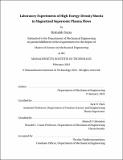Laboratory Experiments of High-Energy-Density Shocks in Magnetized Supersonic Plasma Flows
Author(s)
Datta, Rishabh
DownloadThesis PDF (46.46Mb)
Advisor
Hare, Jack D.
Terms of use
Metadata
Show full item recordAbstract
Magnetized shocks are of interest in many astrophysical environments, in which high Mach number flows interact with ambient media, planetary obstacles, and/or spacecraft to generate strongly radiating shocks. Some examples include extrastellar jets from radio galaxies, relativistic jets from quasars and blazars, Herbig-Haro jets from Young Stellar Objects, and shocks in core-collapse supernovae and supernova remnants. In this study, we mimic these extreme astrophysical environments using pulsed-power driven high-energy-density-plasma laboratory experiments, by generating hypersonic, magnetized large-Reynolds’ number plasma flows, using exploding z-pinch wire arrays on the MAGPIE facility (1.4 MA peak current, 250 ns rise time). Plasma flows from adjacent wire cores expand and generate oblique shock structures, resulting in modulation of the plasma flow. These flows collide with inductive probes placed in the flow, which serve both as the obstacles that generate the magnetized bow shocks, and as diagnostics of the advected magnetic field. The oblique shocks, which are represented by oblique discontinuities in electron density, are observed to exhibit hollow density profiles. A detached bow shock forms ahead of the probe and exhibits a fully 3D structure, with a larger opening angle in the plane parallel to the magnetic field, than in the plane normal to it. We use the shock Mach angle to determine the upstream Mach number (5 − 8) of the flow. We also introduce a novel technique to estimate the flow velocity and temperature of pulsed-power driven plasmas, via simultaneous imaging of inductive probes and measurement of the inductive probe signal. The velocity and temperature estimated using this method are consistent with values reported in literature. Experimental results are compared with full 3D simulations performed using the resistive MHD code GORGON, and synthetic Thompson scattering spectra are generated, which form the basis of future experiments.
Date issued
2022-02Department
Massachusetts Institute of Technology. Department of Mechanical EngineeringPublisher
Massachusetts Institute of Technology